Abstract
This paper is a selective review of the methods, problems, and findings in the area of operant stimulus generalization over the 25 years since the publication of the original paper by Guttman and Kalish (1956) on discriminability and spectral generalization in the pigeon. The paper falls into five main sections, which encompass the main themes and problems stemming from the Guttman and Kalish work and its immediate successors. The first section addresses the relationship between stimulus generalization and stimulus control, as well as the variety of testing procedures and dependent variables used to measure generalization. The next section reviews the limited literature on the effects of early rearing on the generalization gradient. The relationship between discriminability among test stimuli and the slope of the spectral gradient is discussed in the third section, with emphasis upon recent reassessments of the pigeon's hue discriminability function. The fourth section reviews the topic of inhibitory stimulus control, one which developed with the discovery of the peak shift following intradimensional discrimination training. Problems of definition and measurement are discussed in conjunction with the gradient forms used to index inhibitory control. The last section is devoted to attentional effects and the two principal theories postulated to account for them. A survey of different attentional paradigms is provided and the possible role of constant irrelevant stimuli as a source of control is examined. A brief conclusion summarizes the contribution of the generalization technique toward an understanding of the nature and acquisition of stimulus control.
Keywords: Stimulus generalization, generalization gradients, early rearing, discriminability, inhibitory stimulus control, attention, pigeons
Full text
PDF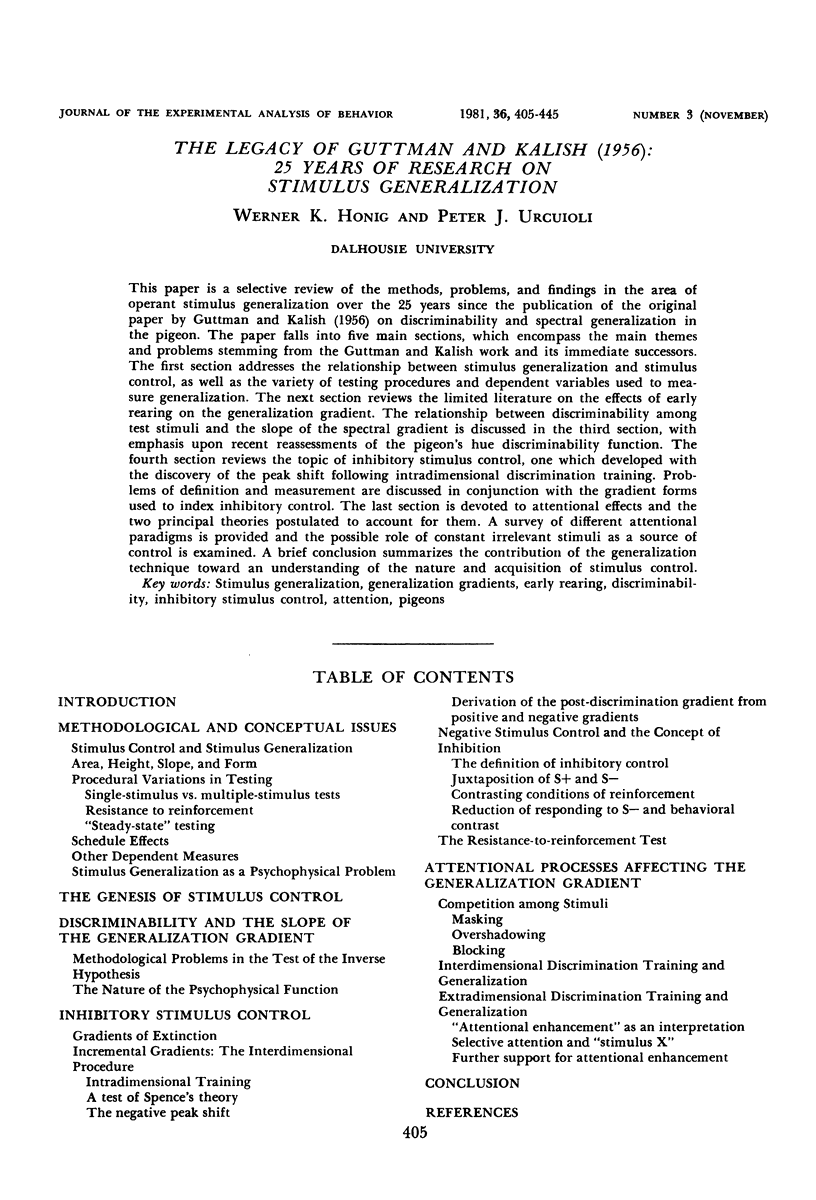
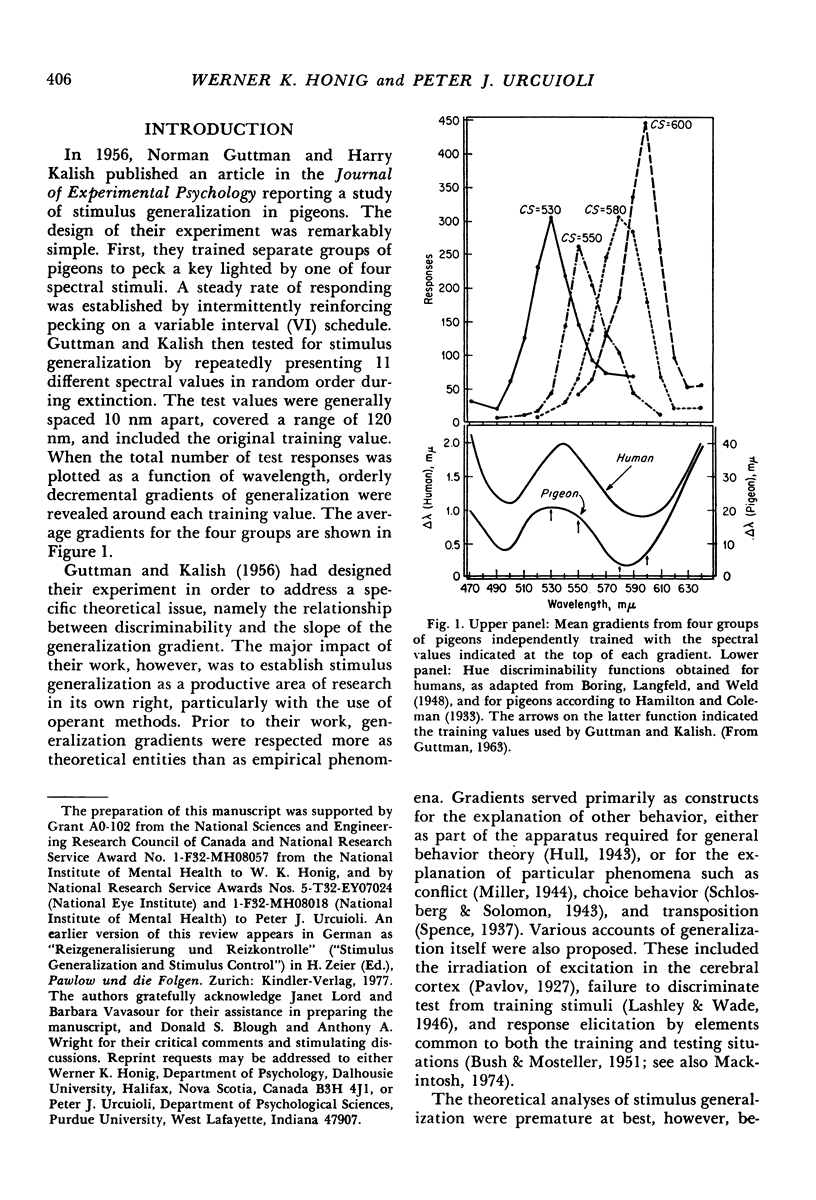

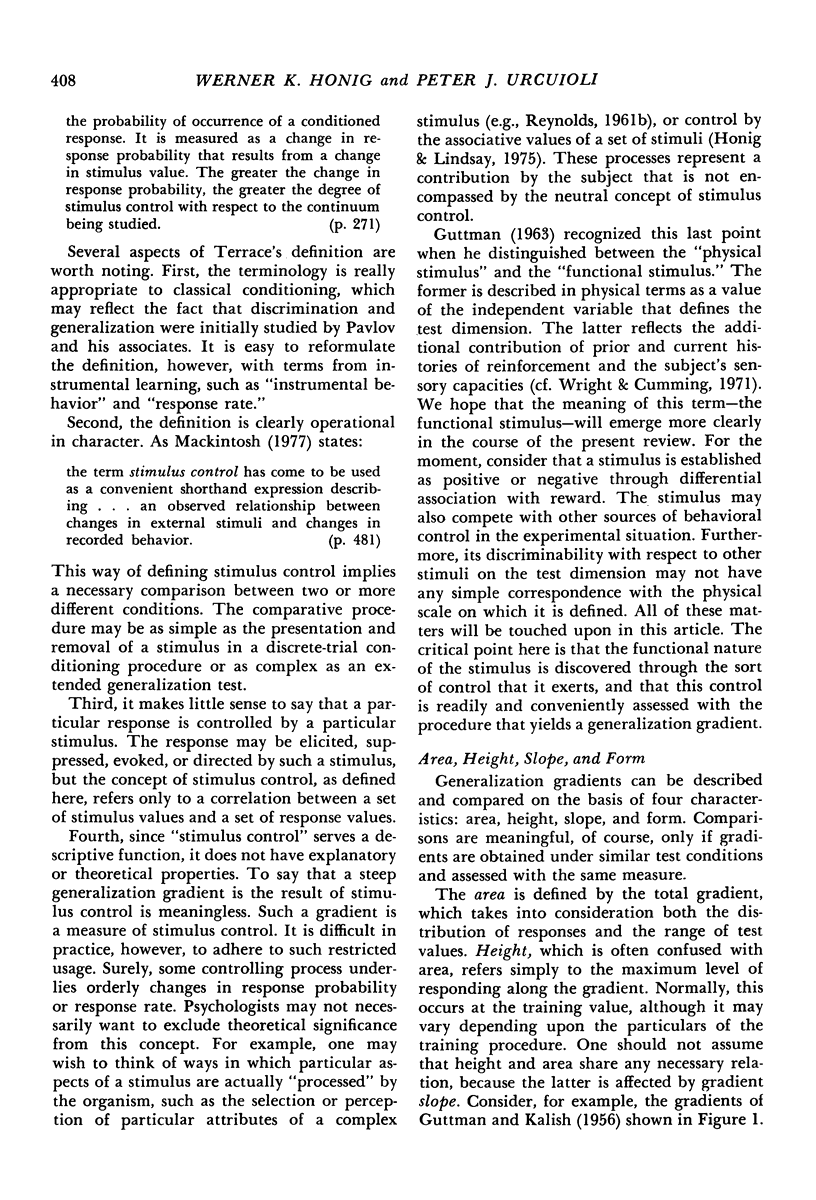
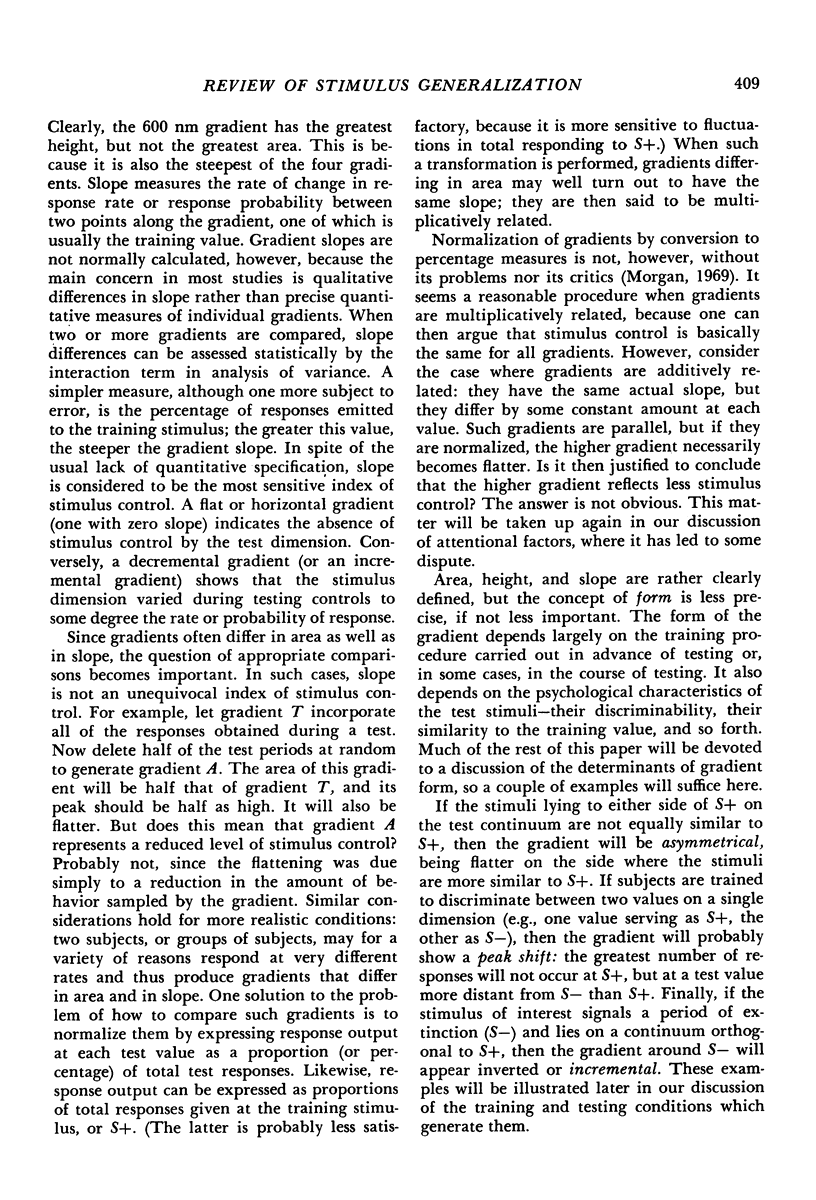
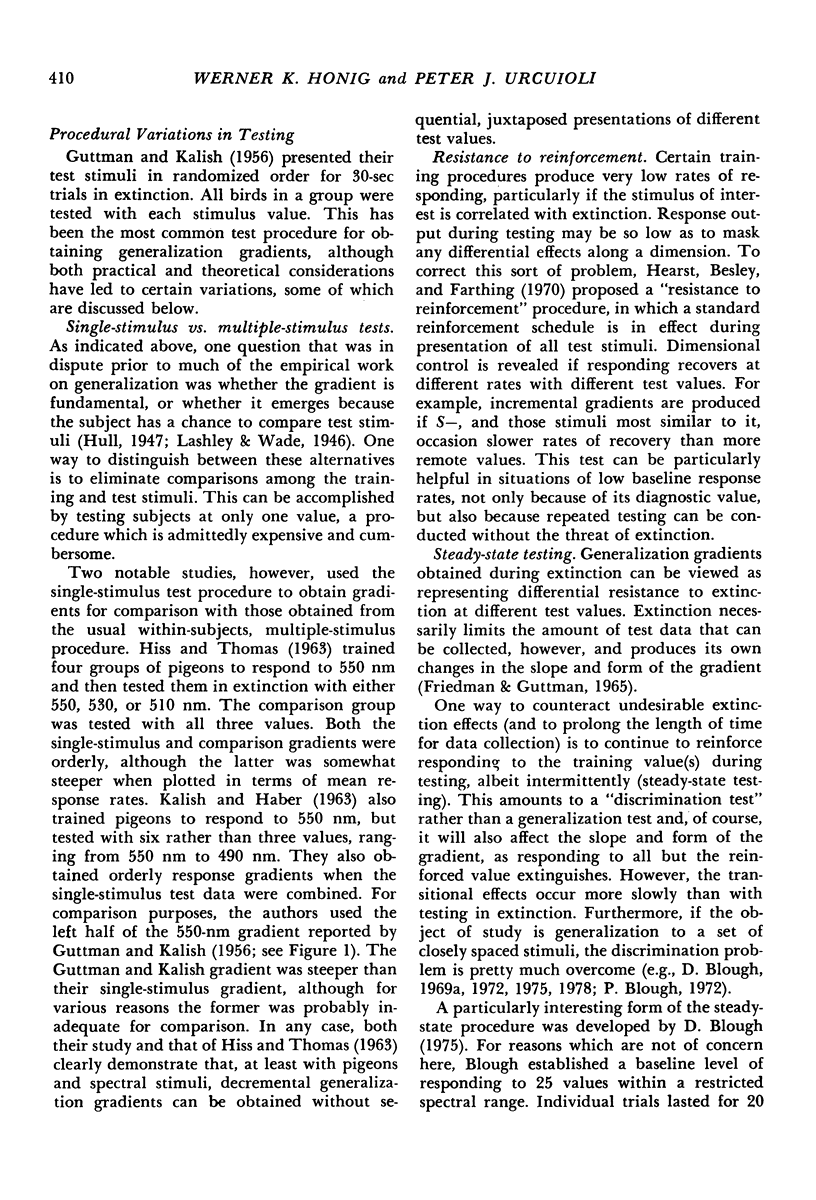
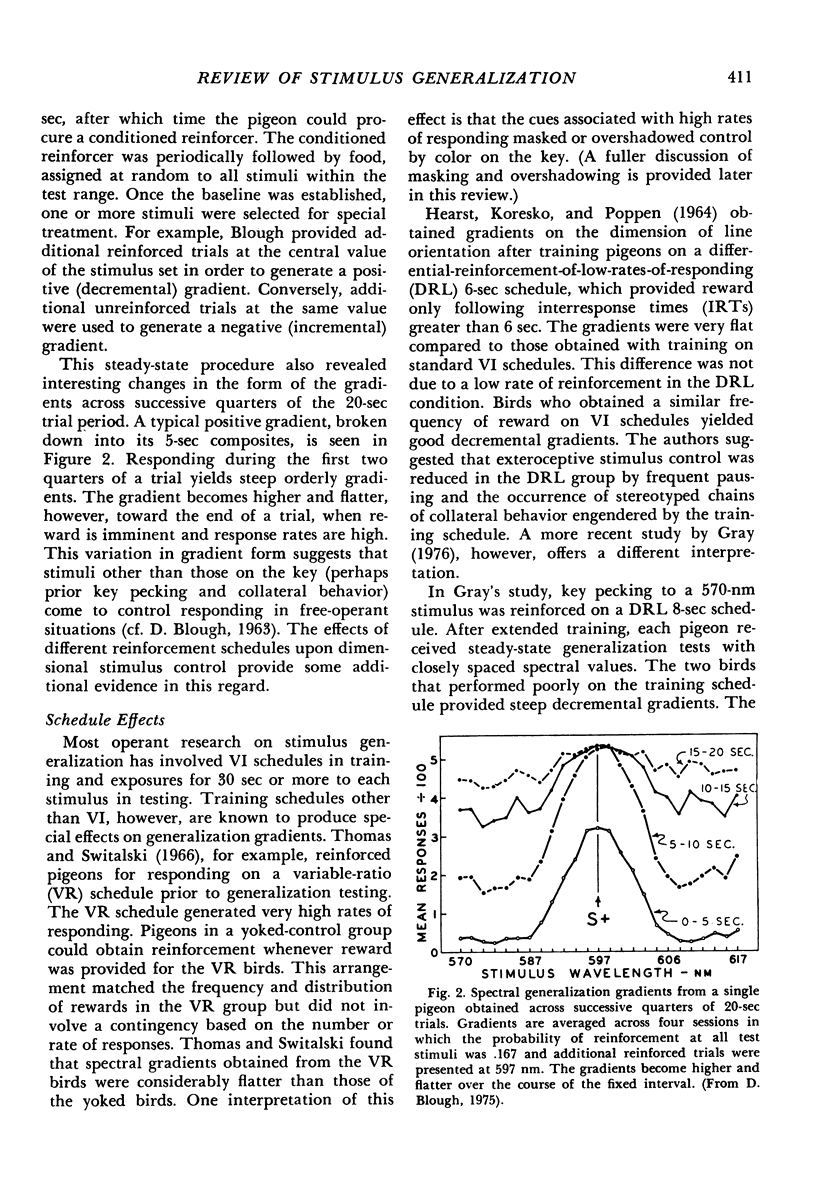
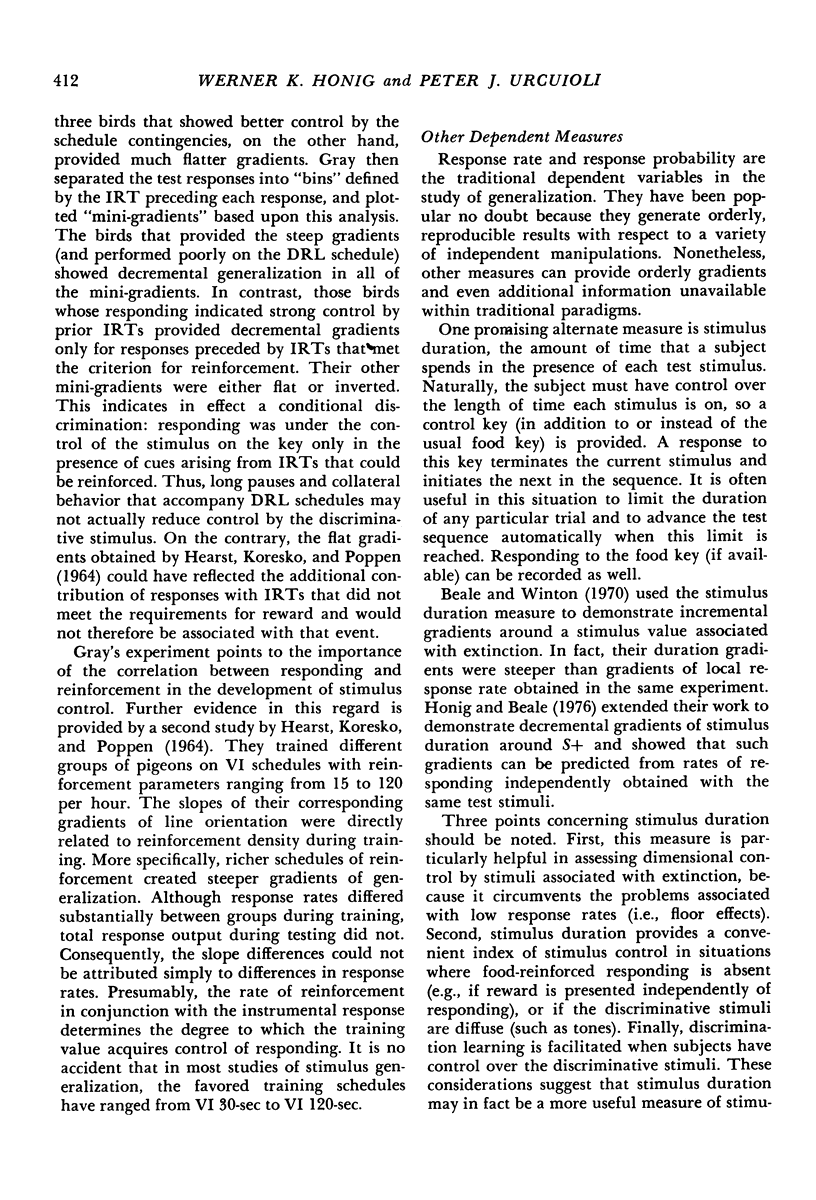
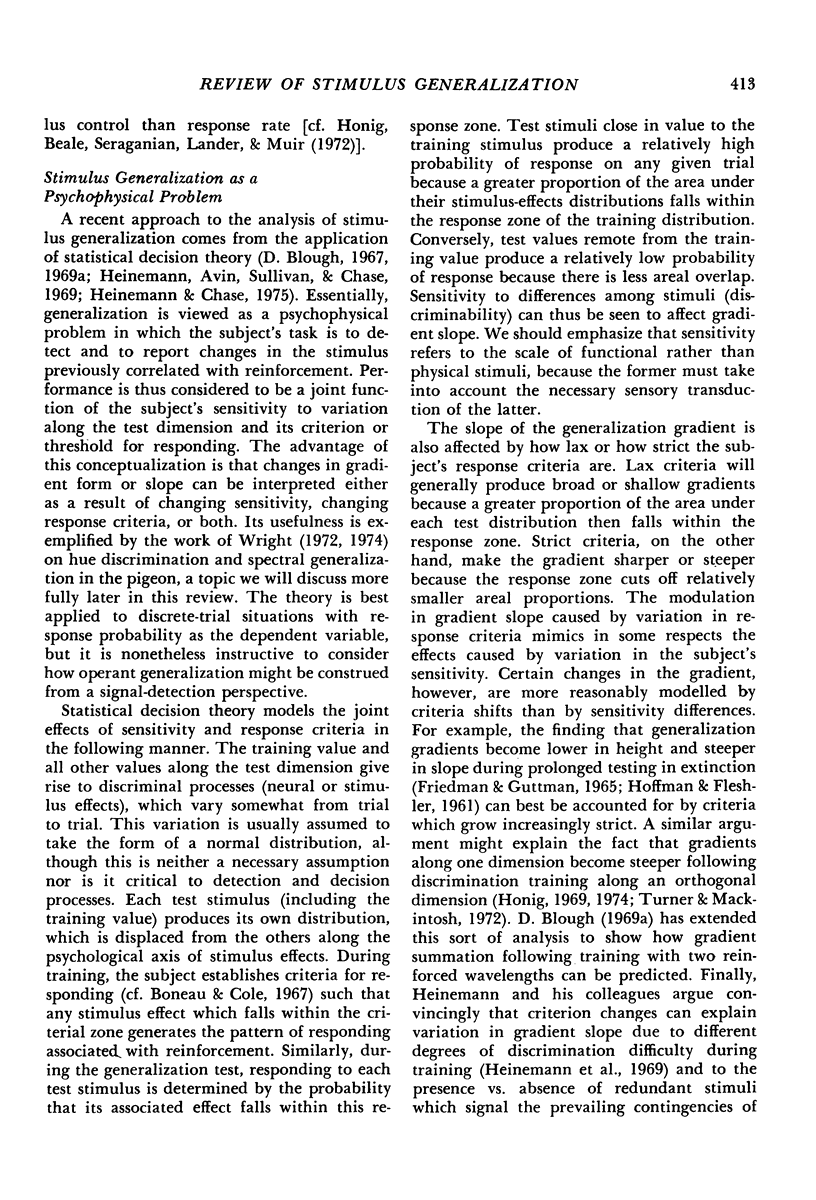


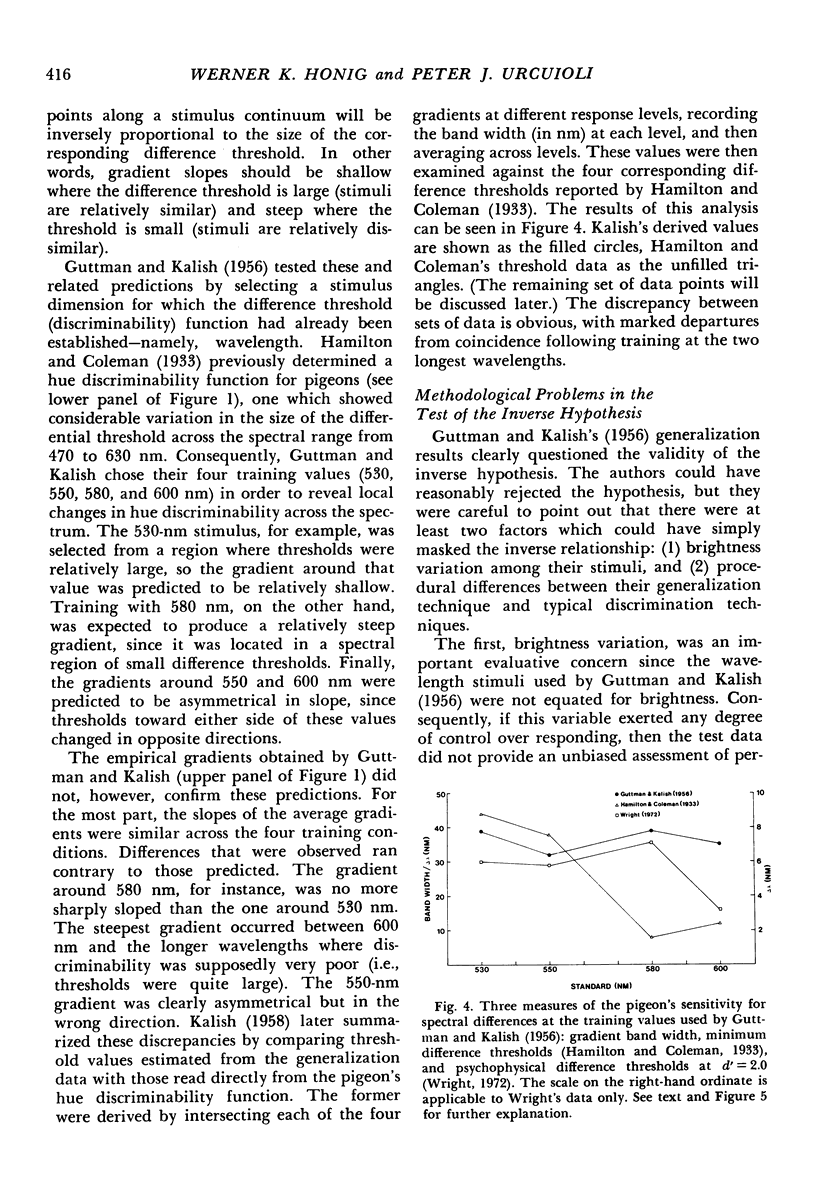
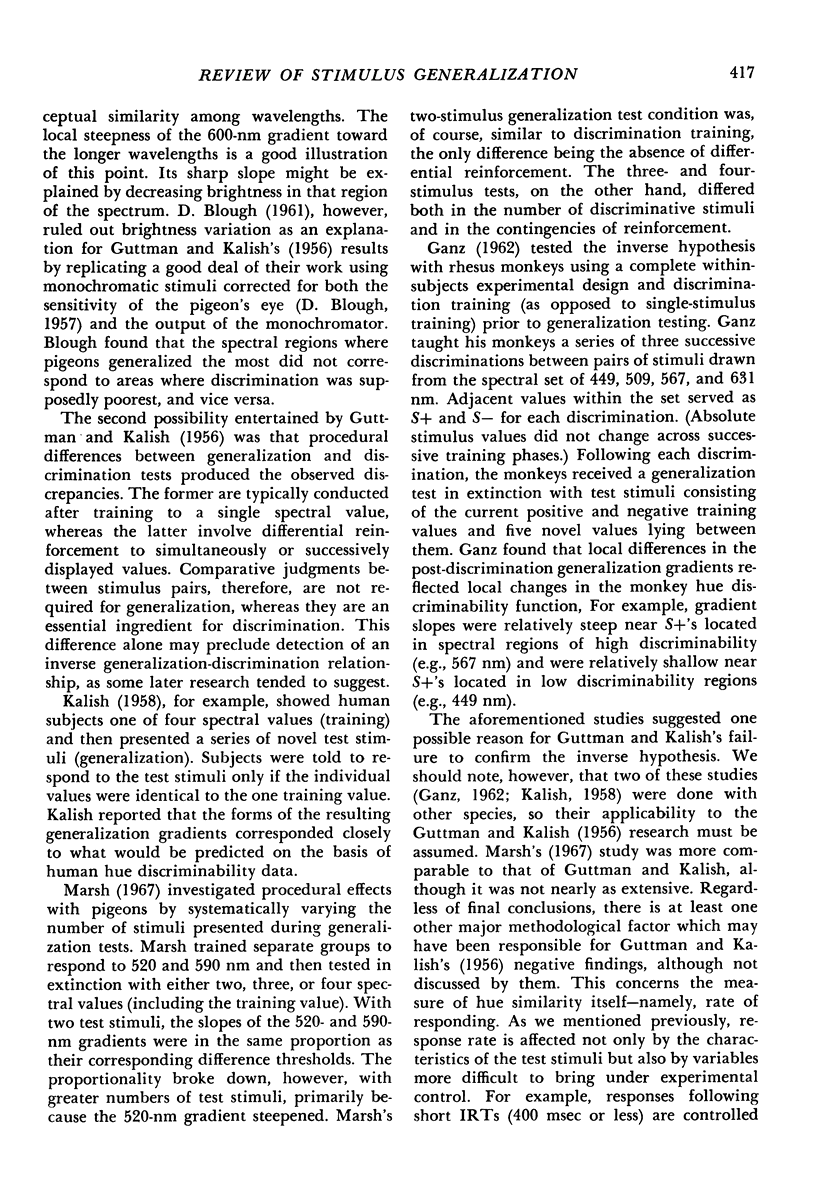
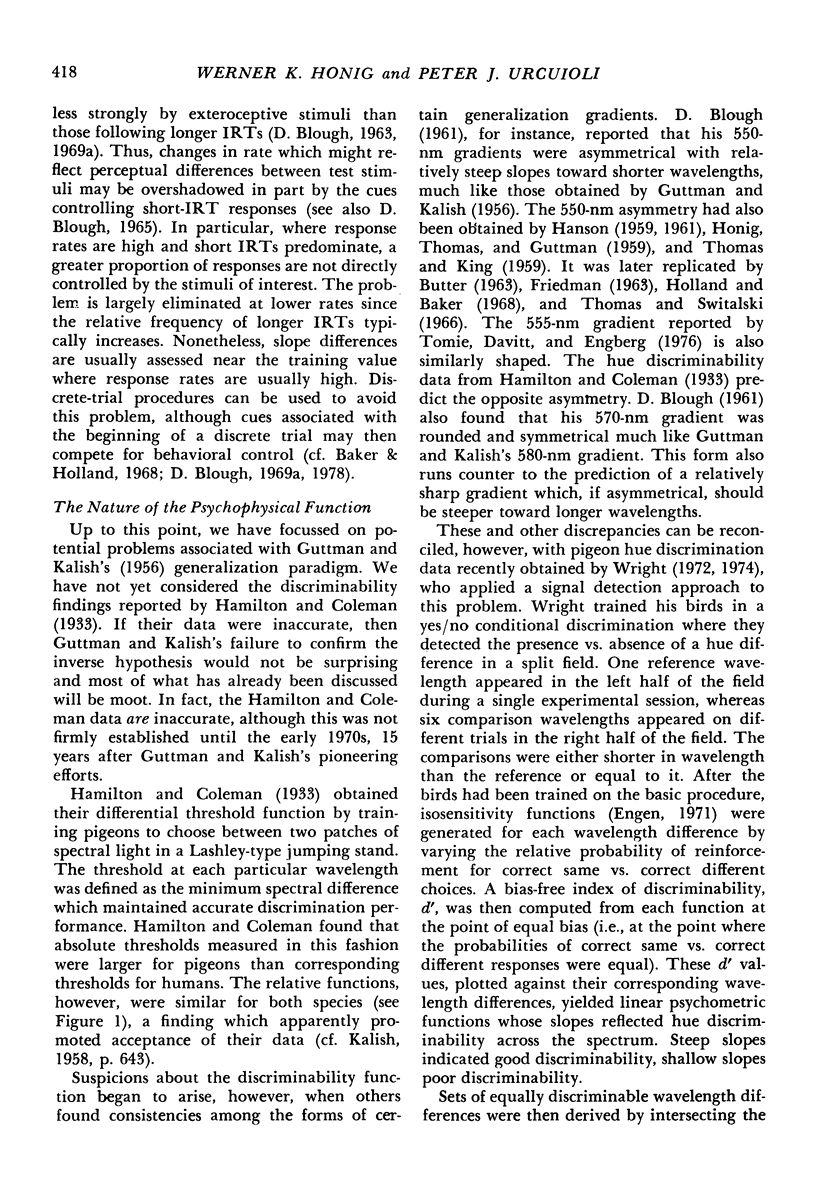
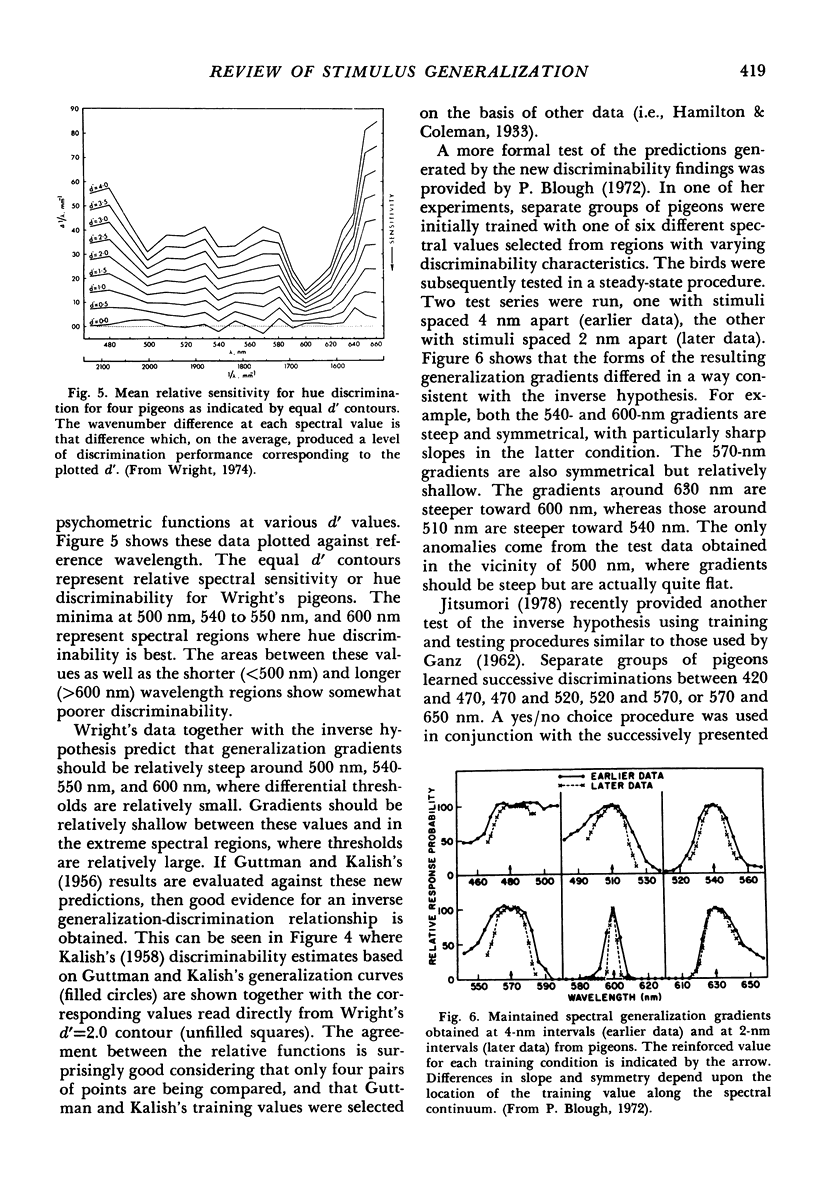




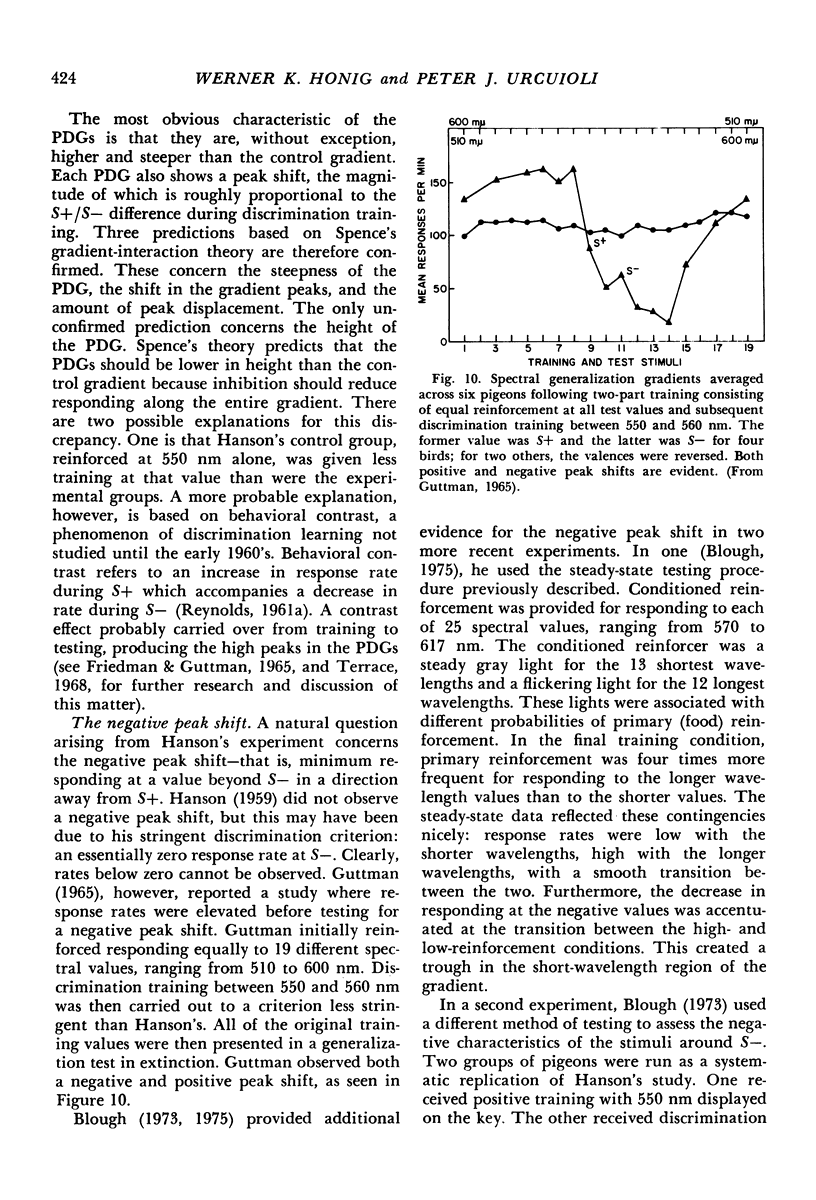
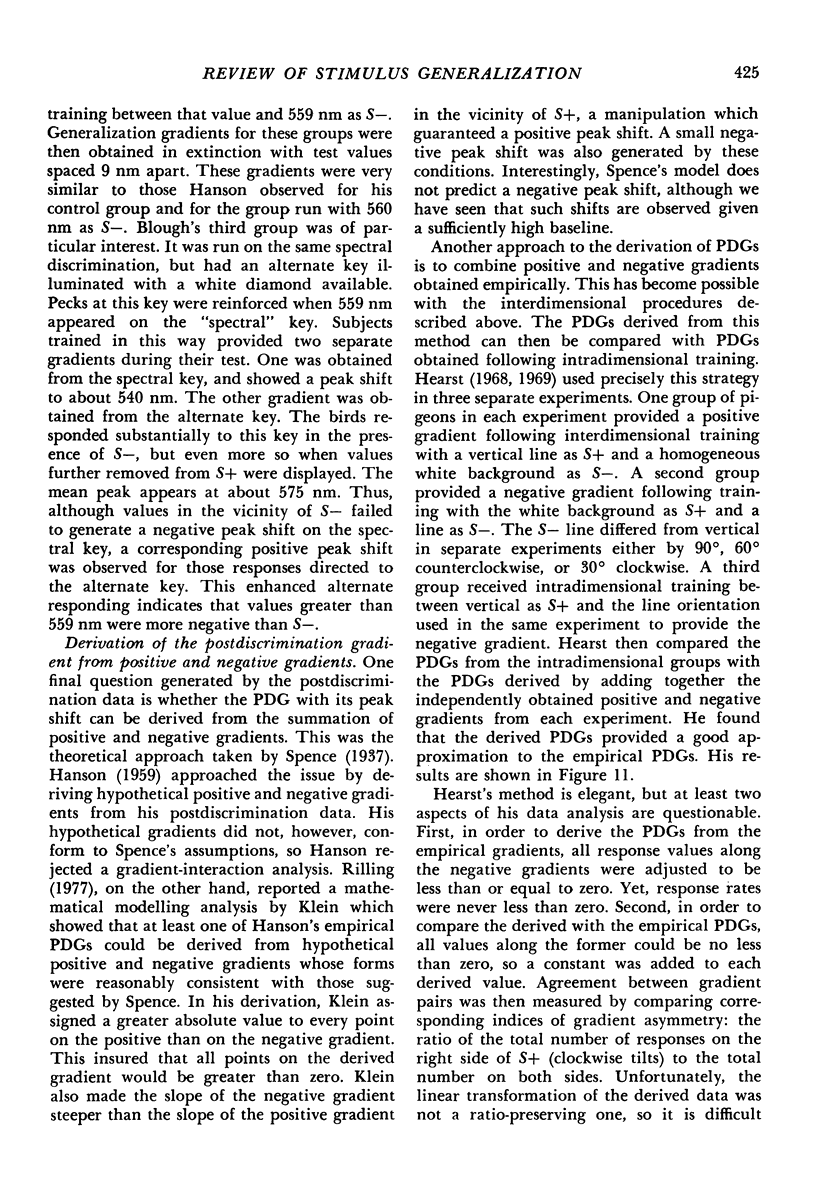
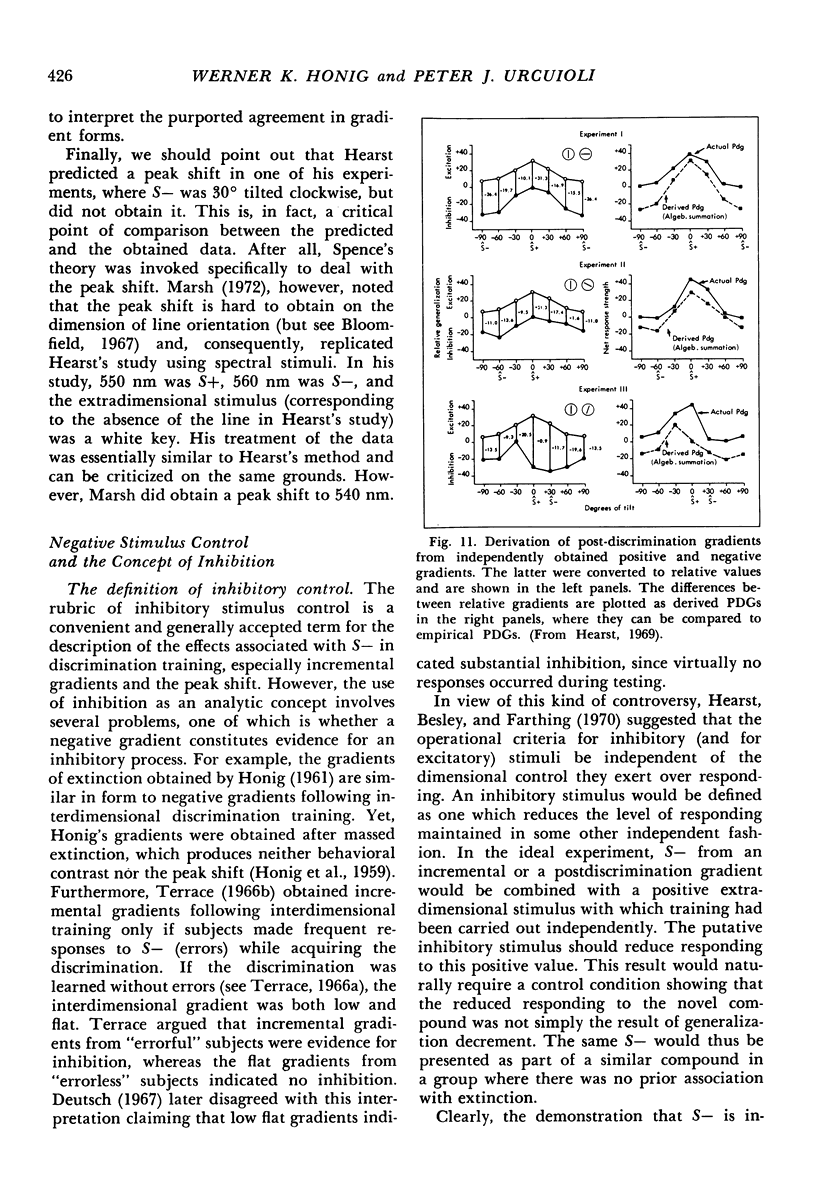


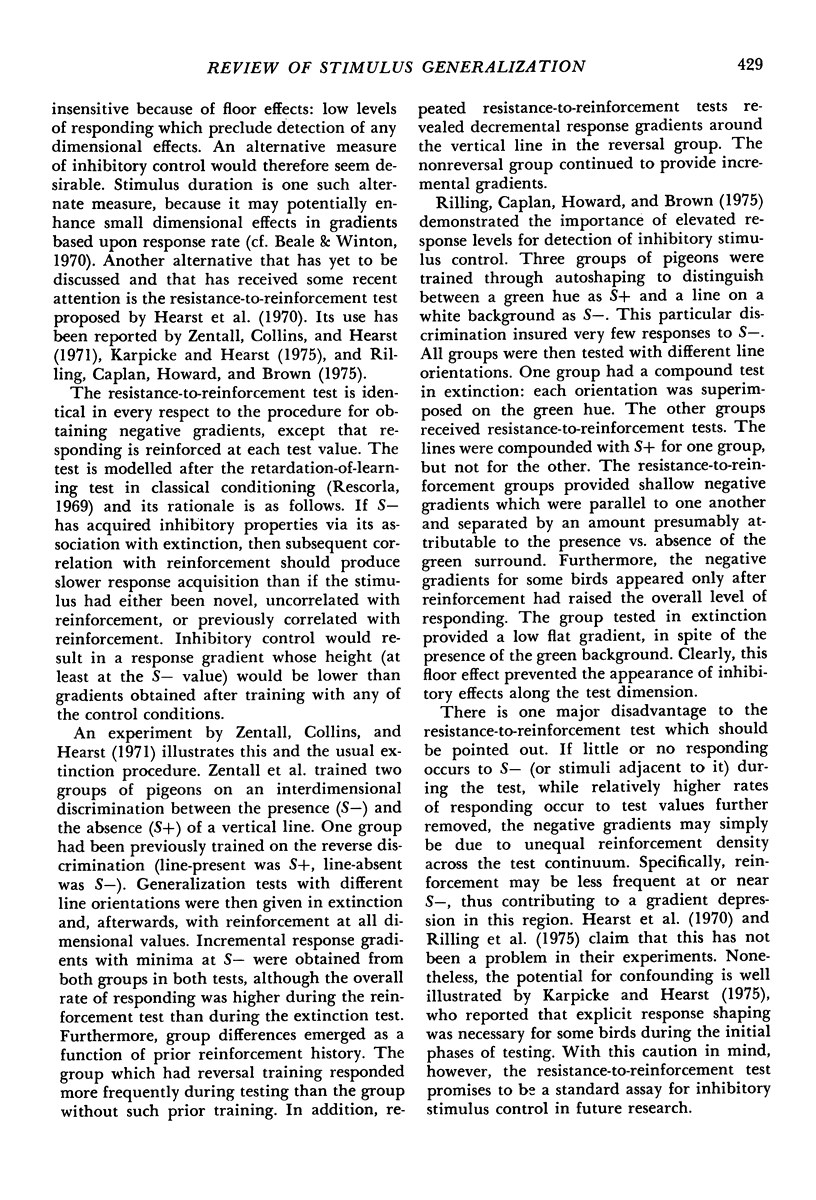

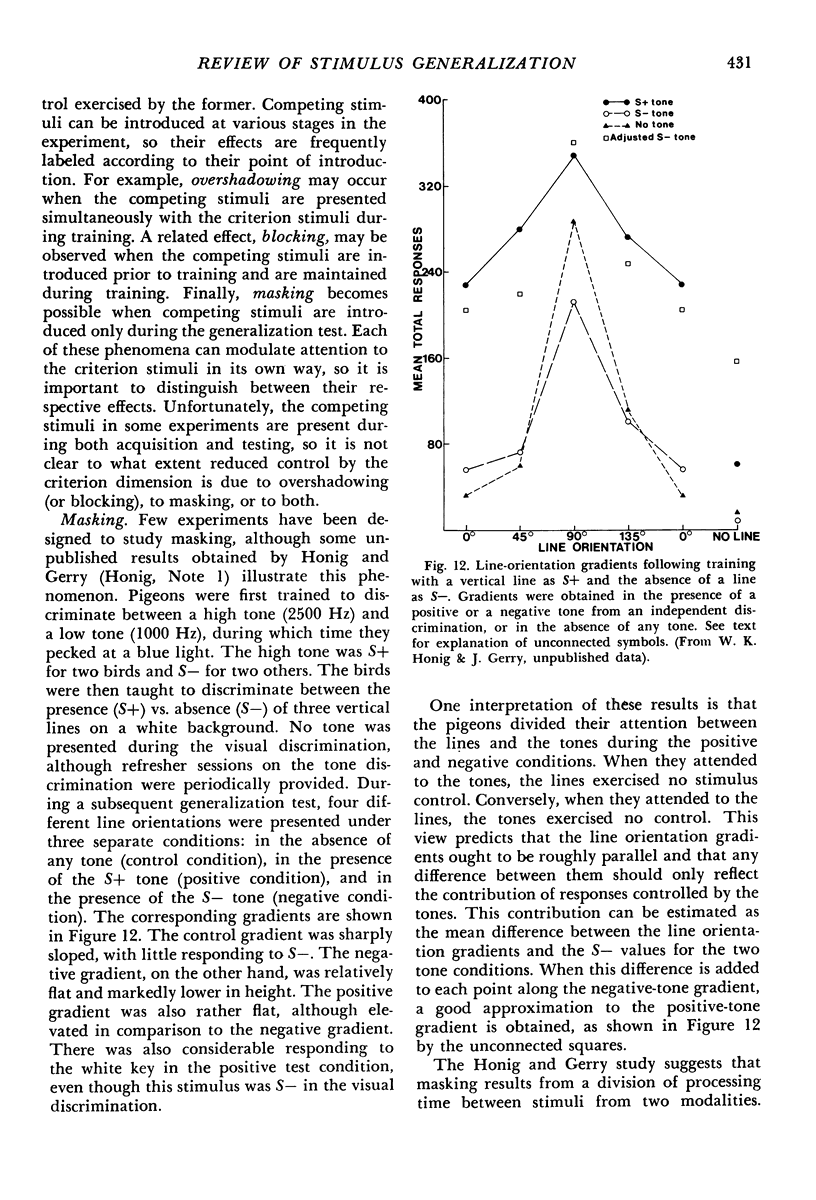
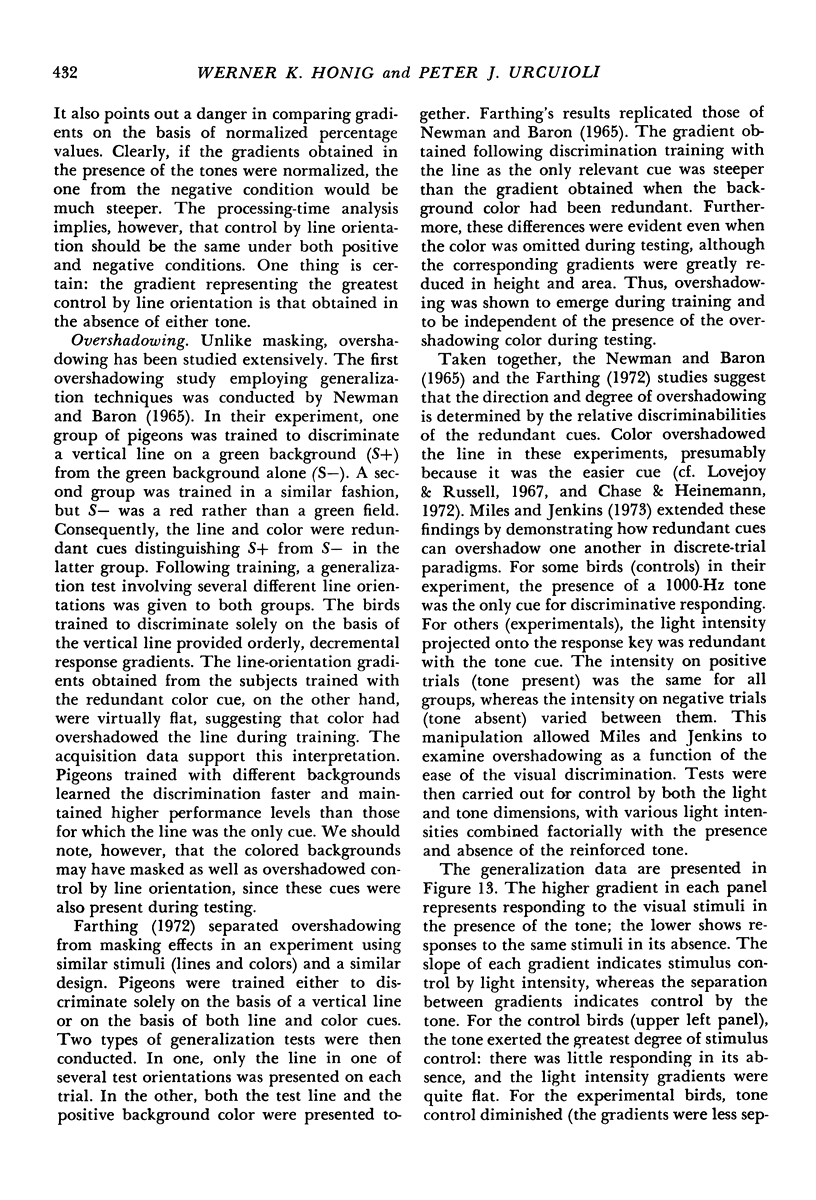

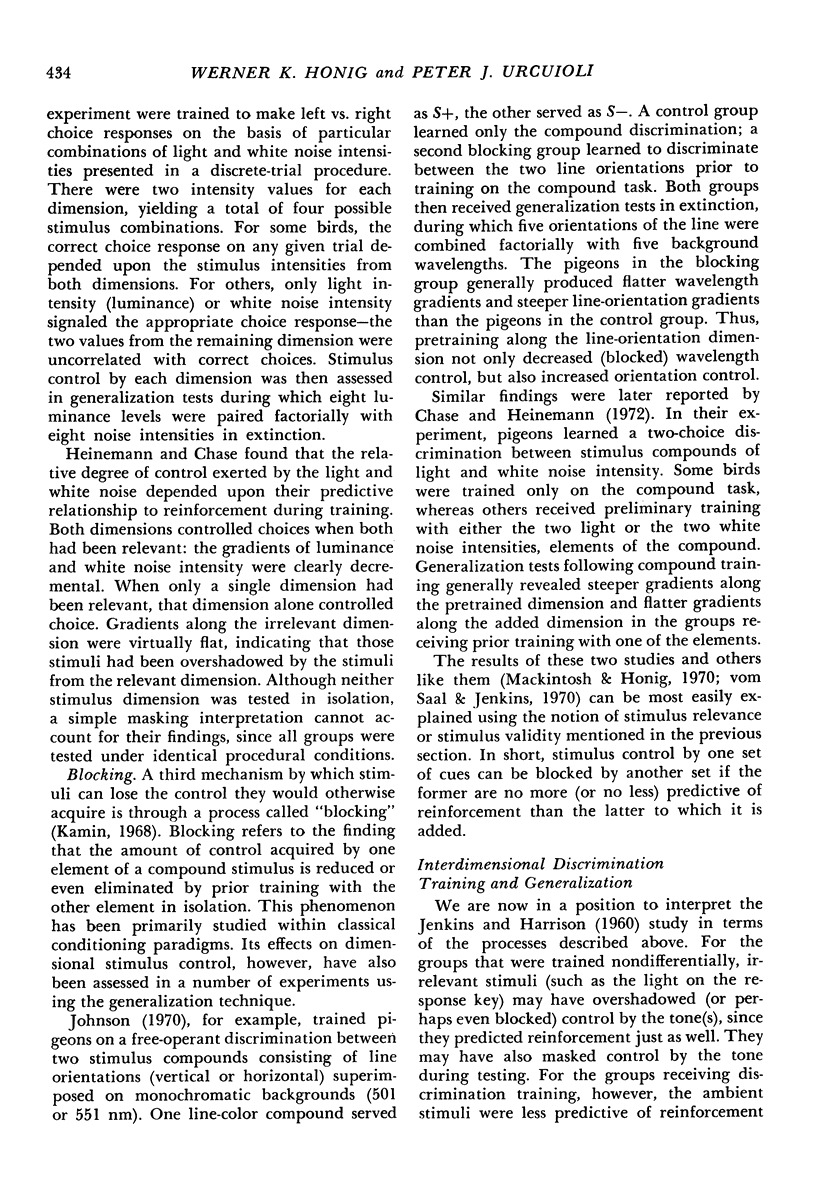
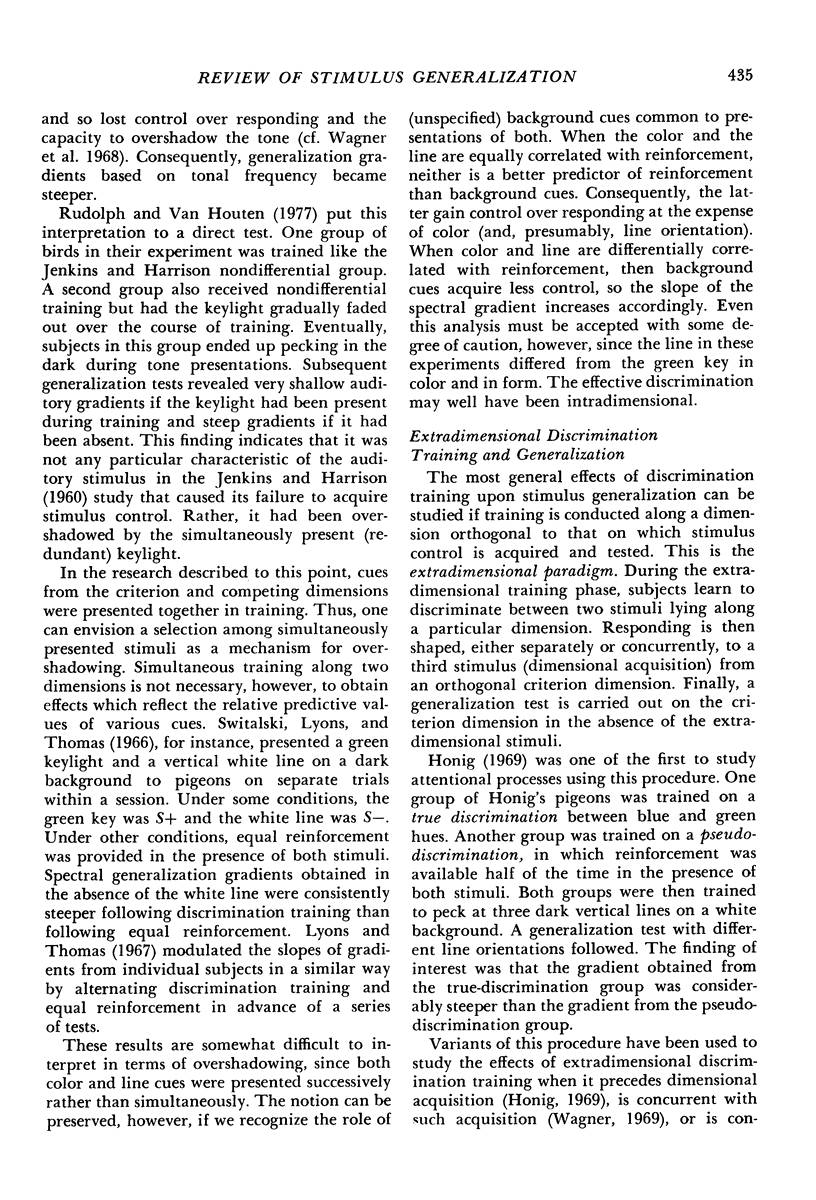

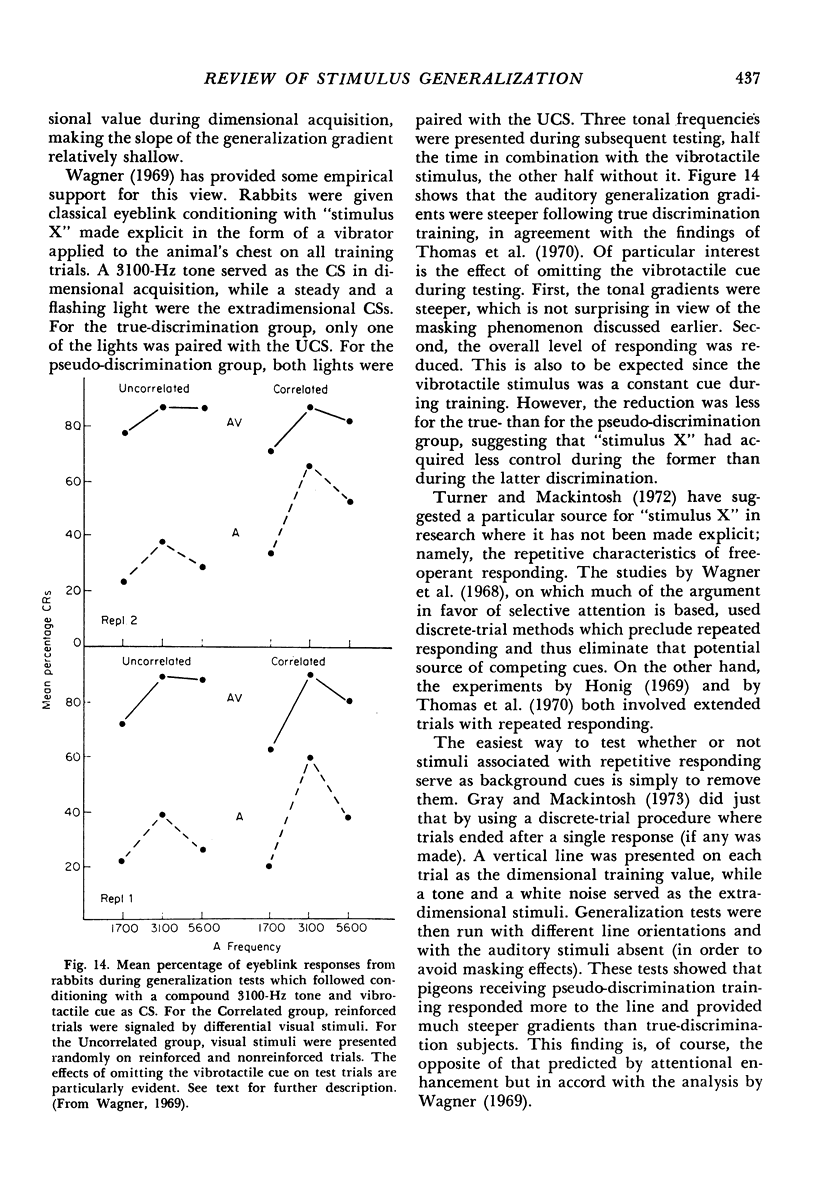



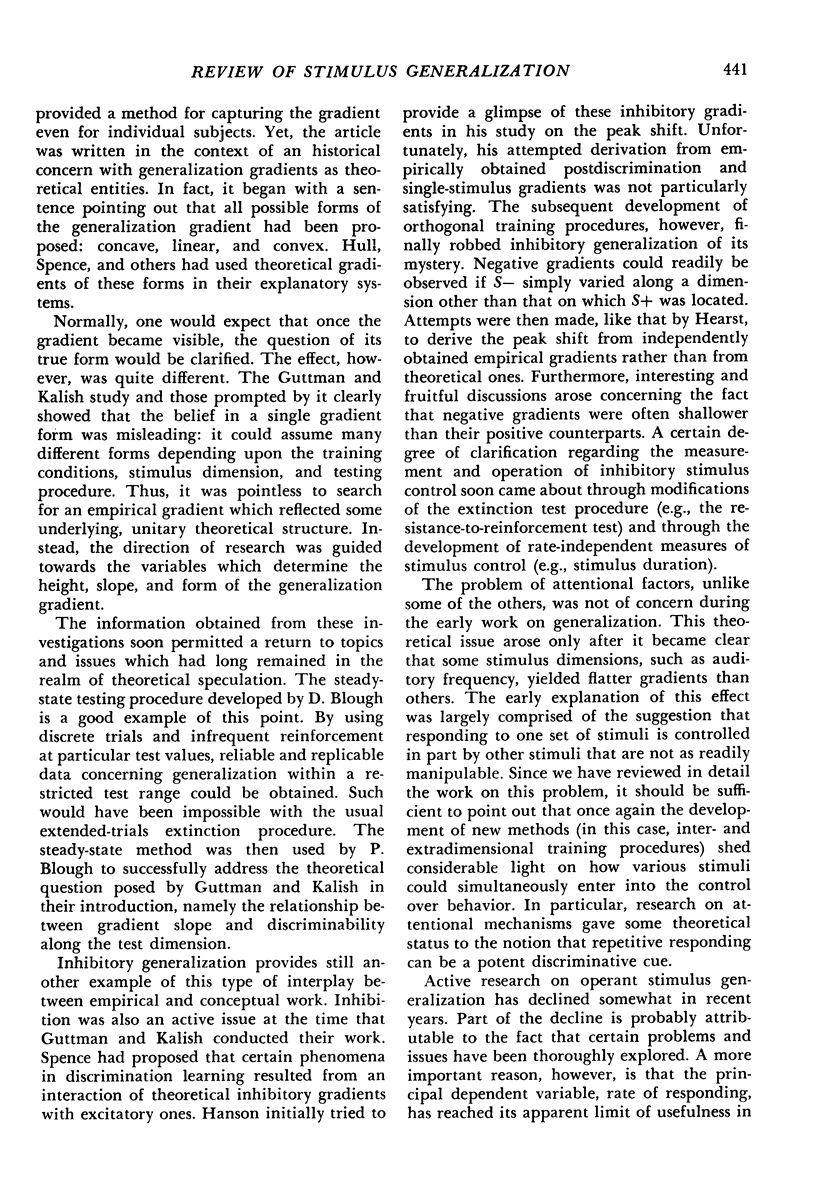
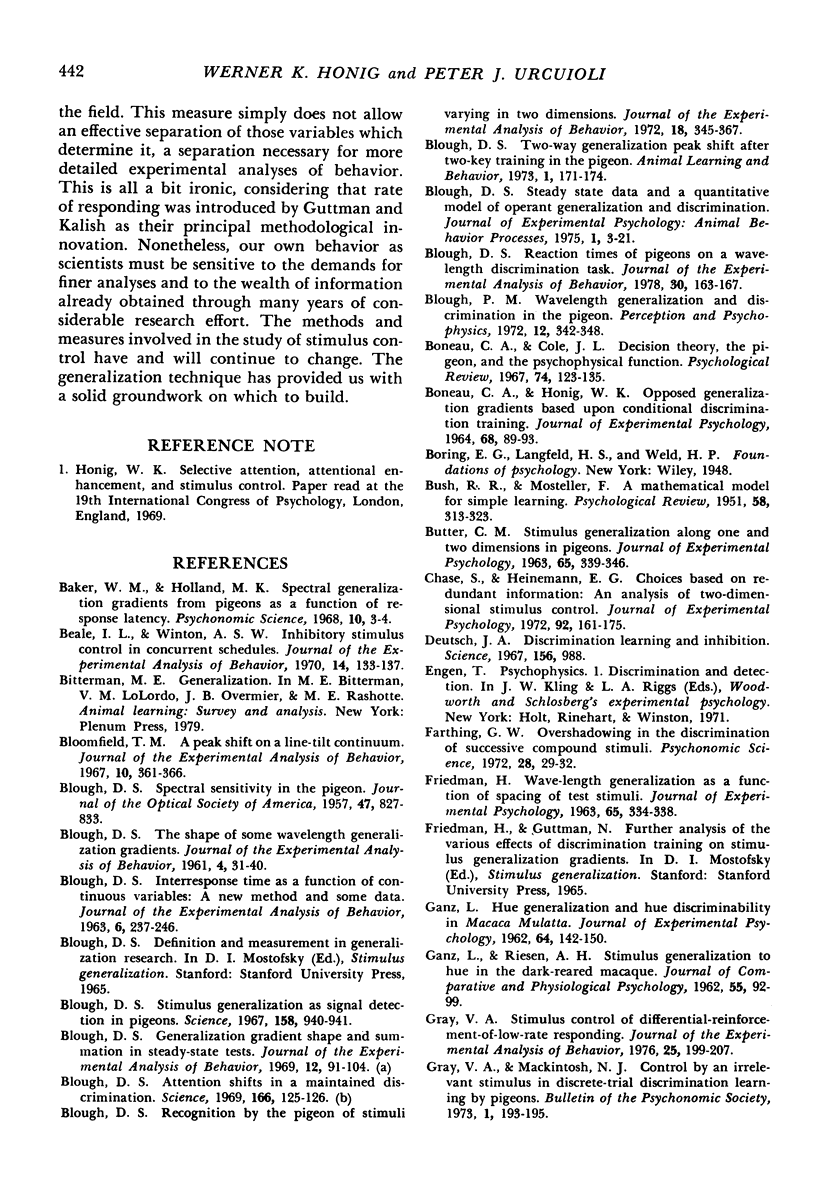

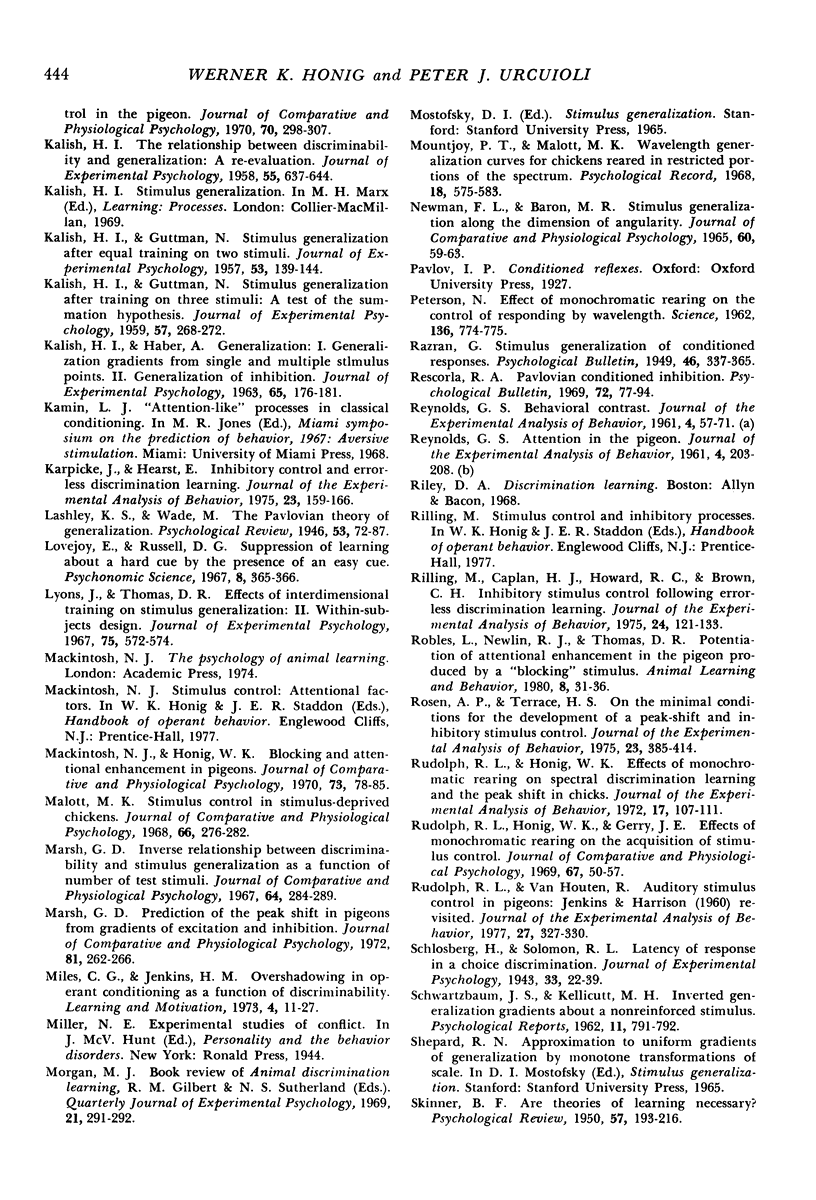

Selected References
These references are in PubMed. This may not be the complete list of references from this article.
- BLOUGH D. S. Spectral sensitivity in the pigeon. J Opt Soc Am. 1957 Sep;47(9):827–833. doi: 10.1364/josa.47.000827. [DOI] [PubMed] [Google Scholar]
- BONEAU C. A., HONIG W. K. OPPOSED GENERALIZATION GRADIENTS BASED UPON CONDITIONAL DISCRIMINATION TRAINING. J Exp Psychol. 1964 Jul;68:89–93. doi: 10.1037/h0045926. [DOI] [PubMed] [Google Scholar]
- BUSH R. R., MOSTELLER F. A mathematical model for simple learning. Psychol Rev. 1951 Sep;58(5):313–323. doi: 10.1037/h0054388. [DOI] [PubMed] [Google Scholar]
- BUTTER C. M. Stimulus generalization along one and two dimensions in pigeons. J Exp Psychol. 1963 Apr;65:339–346. doi: 10.1037/h0040258. [DOI] [PubMed] [Google Scholar]
- Beale I. L., Winton A. S. Inhibitory stimulus control in concurrent schedules. J Exp Anal Behav. 1970 Sep;14(2):133–137. doi: 10.1901/jeab.1970.14-133. [DOI] [PMC free article] [PubMed] [Google Scholar]
- Bloomfield T. M. A peak shift on a line-tilt continuum. J Exp Anal Behav. 1967 Jul;10(4):361–366. doi: 10.1901/jeab.1967.10-361. [DOI] [PMC free article] [PubMed] [Google Scholar]
- Blough D. S. Attention shifts in a maintained discrimination. Science. 1969 Oct 3;166(3901):125–126. doi: 10.1126/science.166.3901.125. [DOI] [PubMed] [Google Scholar]
- Blough D. S. Generalization gradient shape and summation in steady-state tests. J Exp Anal Behav. 1969 Jan;12(1):91–104. doi: 10.1901/jeab.1969.12-91. [DOI] [PMC free article] [PubMed] [Google Scholar]
- Blough D. S. Interresponse time as a function of continuous variables: a new method and some data. J Exp Anal Behav. 1963 Apr;6(2):237–246. doi: 10.1901/jeab.1963.6-237. [DOI] [PMC free article] [PubMed] [Google Scholar]
- Blough D. S. Reaction times of pigeons on a wavelength discrimination task. J Exp Anal Behav. 1978 Sep;30(2):163–167. doi: 10.1901/jeab.1978.30-163. [DOI] [PMC free article] [PubMed] [Google Scholar]
- Blough D. S. Recognition by the pigeon of stimuli varying in two dimensions. J Exp Anal Behav. 1972 Nov;18(3):345–367. doi: 10.1901/jeab.1972.18-345. [DOI] [PMC free article] [PubMed] [Google Scholar]
- Blough D. S. Stimulus generalization as signal detection in pigeons. Science. 1967 Nov 17;158(3803):940–941. doi: 10.1126/science.158.3803.940. [DOI] [PubMed] [Google Scholar]
- Blough D. S. The shape of some wavelength generalization gradients. J Exp Anal Behav. 1961 Jan;4(1):31–40. doi: 10.1901/jeab.1961.4-31. [DOI] [PMC free article] [PubMed] [Google Scholar]
- Boneau C. A., Cole J. L. Decision theory, the pigeon, and the psychophysical function. Psychol Rev. 1967 Mar;74(2):123–135. doi: 10.1037/h0024287. [DOI] [PubMed] [Google Scholar]
- Chase S., Heinemann E. G. Choices based on redundant information: an analysis of two-dimensional stimulus control. J Exp Psychol. 1972 Feb;92(2):161–175. doi: 10.1037/h0032083. [DOI] [PubMed] [Google Scholar]
- Deutsch J. A., Terrace H. S. Discrimination learning and inhibition. Science. 1967 May 19;156(3777):988–989. doi: 10.1126/science.156.3777.988. [DOI] [PubMed] [Google Scholar]
- FRIEDMAN H. Wave-length generalization as a function of spacing of test stimuli. J Exp Psychol. 1963 Apr;65:334–338. doi: 10.1037/h0048131. [DOI] [PubMed] [Google Scholar]
- GANZ L. Hue generalization and hue discriminability in Macaca mulatta. J Exp Psychol. 1962 Aug;64:142–150. doi: 10.1037/h0041688. [DOI] [PubMed] [Google Scholar]
- GANZ L., RIESEN A. H. Stimulus generalization to hue in the dark-reared macaque. J Comp Physiol Psychol. 1962 Feb;55:92–99. doi: 10.1037/h0044987. [DOI] [PubMed] [Google Scholar]
- GUTTMAN N. Generalization gradients around stimuli associated with different reinforcement schedules. J Exp Psychol. 1959 Nov;58:335–340. doi: 10.1037/h0045679. [DOI] [PubMed] [Google Scholar]
- GUTTMAN N., KALISH H. I. Discriminability and stimulus generalization. J Exp Psychol. 1956 Jan;51(1):79–88. doi: 10.1037/h0046219. [DOI] [PubMed] [Google Scholar]
- Gray V. A. Stimulus control of differential-reinforcement-of-low-rate responding. J Exp Anal Behav. 1976 Mar;25(2):199–207. doi: 10.1901/jeab.1976.25-199. [DOI] [PMC free article] [PubMed] [Google Scholar]
- HANSON H. M. Effects of discrimination training on stimulus generalization. J Exp Psychol. 1959 Nov;58:321–334. doi: 10.1037/h0042606. [DOI] [PubMed] [Google Scholar]
- HANSON H. M. Stimulus generalization following three-stimulus discrimination training. J Comp Physiol Psychol. 1961 Apr;54:181–185. doi: 10.1037/h0041866. [DOI] [PubMed] [Google Scholar]
- HEARST E., KORESKO M. B., POPPEN R. STIMULUS GENERALIZATION AND THE RESPONSE-REINFORCEMENT CONTINGENCY. J Exp Anal Behav. 1964 Sep;7:369–380. doi: 10.1901/jeab.1964.7-369. [DOI] [PMC free article] [PubMed] [Google Scholar]
- HISS R. H., THOMAS D. R. Stimulus generalization as a function of testing procedure and response measure. J Exp Psychol. 1963 Jun;65:587–592. doi: 10.1037/h0048117. [DOI] [PubMed] [Google Scholar]
- HOFFMAN H. S., FLESHLER M. Stimulus factors in aversive controls: the generalization of conditioned suppression. J Exp Anal Behav. 1961 Oct;4:371–378. doi: 10.1901/jeab.1961.4-371. [DOI] [PMC free article] [PubMed] [Google Scholar]
- HONIG W. K. Prediction of preference, transposition, and transposition-reversal from the generalization gradient. J Exp Psychol. 1962 Sep;64:239–248. doi: 10.1037/h0048290. [DOI] [PubMed] [Google Scholar]
- HONIG W. K., THOMAS D. R., GUTTM AN N. Differential effects of continuous extinction and discrimination training on the generalization gradient. J Exp Psychol. 1959 Aug;58:145–152. doi: 10.1037/h0048484. [DOI] [PubMed] [Google Scholar]
- Hearst E., Besley S., Farthing G. W. Inhibition and the stimulus control of operant behavior. J Exp Anal Behav. 1970 Nov;14(3 Pt 2 Suppl):373–409. doi: 10.1901/jeab.1970.14-s373. [DOI] [PMC free article] [PubMed] [Google Scholar]
- Hearst E. Discrimination learning as the summation of excitation and inhibition. Science. 1968 Dec 13;162(3859):1303–1306. doi: 10.1126/science.162.3859.1303. [DOI] [PubMed] [Google Scholar]
- Honig W. K., Beale I. L. Stimulus duration as a measure of stimulus generalization. J Exp Anal Behav. 1976 Mar;25(2):209–217. doi: 10.1901/jeab.1976.25-209. [DOI] [PMC free article] [PubMed] [Google Scholar]
- Irvine W. J., Gray R. S., Morris P. J., Ting A. HLA in primary atrophic hypothyroidism and Hashimoto goitre. J Clin Lab Immunol. 1978 Nov;1(3):193–195. [PubMed] [Google Scholar]
- JENKINS H. M., HARRISON R. H. Effect of discrimination training on auditory generalization. J Exp Psychol. 1960 Apr;59:246–253. doi: 10.1037/h0041661. [DOI] [PubMed] [Google Scholar]
- JENKINS H. M., HARRISON R. H. Generalization gradients of inhibition following auditory discrimination learning. J Exp Anal Behav. 1962 Oct;5:435–441. doi: 10.1901/jeab.1962.5-435. [DOI] [PMC free article] [PubMed] [Google Scholar]
- KALISH H. I., GUTTMAN N. Stimulus generalization after equal training on two stimuli. J Exp Psychol. 1957 Feb;53(2):139–144. doi: 10.1037/h0047916. [DOI] [PubMed] [Google Scholar]
- KALISH H. I., GUTTMAN N. Stimulus generalization after training on three stimuli: a test of the summation hypothesis. J Exp Psychol. 1959 Apr;57(4):268–272. doi: 10.1037/h0046433. [DOI] [PubMed] [Google Scholar]
- KALISH H. I. The relationship between discriminability and generalization: a revaluation. J Exp Psychol. 1958 Jun;55(6):637–644. doi: 10.1037/h0048049. [DOI] [PubMed] [Google Scholar]
- Karpicke J., Hearst E. Inhibitory control and errorless discrimination learning. J Exp Anal Behav. 1975 Mar;23(2):159–166. doi: 10.1901/jeab.1975.23-159. [DOI] [PMC free article] [PubMed] [Google Scholar]
- Malott M. K. Stimulus control in stimulus-deprived chickens. J Comp Physiol Psychol. 1968 Oct;66(2):276–282. doi: 10.1037/h0026347. [DOI] [PubMed] [Google Scholar]
- Marsh G. D. Inverse relationship between discriminability and stimulus generalization as a function of number of test stimuli. J Comp Physiol Psychol. 1967 Oct;64(2):284–289. doi: 10.1037/h0088032. [DOI] [PubMed] [Google Scholar]
- Marsh G. Prediction of the peak shift in pigeons from gradients of excitation and inhibition. J Comp Physiol Psychol. 1972 Nov;81(2):262–266. doi: 10.1037/h0033538. [DOI] [PubMed] [Google Scholar]
- NEWMAN F. L., BARON M. R. STIMULUS GENERALIZATION ALONG THE DIMENSION OF ANGULARITY: A COMPARISON OF TRAINING PROCEDURES. J Comp Physiol Psychol. 1965 Aug;60:59–63. doi: 10.1037/h0022334. [DOI] [PubMed] [Google Scholar]
- PETERSON N. Effect of monochromatic rearing on the control of responding by wavelength. Science. 1962 Jun 1;136(3518):774–775. doi: 10.1126/science.136.3518.774. [DOI] [PubMed] [Google Scholar]
- REYNOLDS G. S. Attention in the pigeon. J Exp Anal Behav. 1961 Jul;4:203–208. doi: 10.1901/jeab.1961.4-203. [DOI] [PMC free article] [PubMed] [Google Scholar]
- REYNOLDS G. S. Behavioral contrast. J Exp Anal Behav. 1961 Jan;4:57–71. doi: 10.1901/jeab.1961.4-57. [DOI] [PMC free article] [PubMed] [Google Scholar]
- Rilling M., Caplan H. J., Howard R. C., Brown C. H. Inhibitory stimulus control following errorless discrimination learning. J Exp Anal Behav. 1975 Sep;24(2):121–133. doi: 10.1901/jeab.1975.24-121. [DOI] [PMC free article] [PubMed] [Google Scholar]
- Rosen A. P., Terrace H. S. On the minimal conditions for the development of a peak-shift and inhibitory stimulus control. J Exp Anal Behav. 1975 May;23(3):385–414. doi: 10.1901/jeab.1975.23-385. [DOI] [PMC free article] [PubMed] [Google Scholar]
- Rudolph R. L., Honig W. K. Effects of monochromatic rearing on spectral discrimination learning and the peak shift in chicks. J Exp Anal Behav. 1972 Jan;17(1):107–111. doi: 10.1901/jeab.1972.17-107. [DOI] [PMC free article] [PubMed] [Google Scholar]
- Rudolph R. L., Honig W. K., Gerry J. E. Effects of monochromatic rearing on the acquisition of stimulus control. J Comp Physiol Psychol. 1969 Jan;67(1):50–57. doi: 10.1037/h0026658. [DOI] [PubMed] [Google Scholar]
- Rudolph R. L., Van Houten R. Auditory stimulus control in pigeons: Jenkins and Harrison (1960) revisited. J Exp Anal Behav. 1977 Mar;27(2):327–330. doi: 10.1901/jeab.1977.27-327. [DOI] [PMC free article] [PubMed] [Google Scholar]
- SKINNER B. F. Are theories of learning necessary? Psychol Rev. 1950 Jul;57(4):193–216. doi: 10.1037/h0054367. [DOI] [PubMed] [Google Scholar]
- Switalski R. W., Lyons J., Thomas D. R. Effects of interdimensional training on stimulus generalization. J Exp Psychol. 1966 Nov;72(5):661–666. doi: 10.1037/h0023795. [DOI] [PubMed] [Google Scholar]
- TERRACE H. S. Errorless transfer of a discrimination across two continua. J Exp Anal Behav. 1963 Apr;6:223–232. doi: 10.1901/jeab.1963.6-223. [DOI] [PMC free article] [PubMed] [Google Scholar]
- TERRACE H. S. WAVELENGTH GENERALIZATION AFTER DISCRIMINATION LEARNING WITH AND WITHOUT ERRORS. Science. 1964 Apr 3;144(3614):78–80. doi: 10.1126/science.144.3614.78. [DOI] [PubMed] [Google Scholar]
- THOMAS D. R., KING R. A. Stimulus generalization as a function of level of motivation. J Exp Psychol. 1959 May;57(5):323–328. doi: 10.1037/h0042183. [DOI] [PubMed] [Google Scholar]
- Terrace H. S. Behavioral contrast and the peak shift: effects of extended discrimination training. J Exp Anal Behav. 1966 Nov;9(6):613–617. doi: 10.1901/jeab.1966.9-613. [DOI] [PMC free article] [PubMed] [Google Scholar]
- Terrace H. S. Discrimination learning and inhibition. Science. 1966 Dec 30;154(3757):1677–1680. doi: 10.1126/science.154.3757.1677. [DOI] [PubMed] [Google Scholar]
- Terrace H. S. Discrimination learning, the peak shift, and behavioral contrast. J Exp Anal Behav. 1968 Nov;11(6):727–741. doi: 10.1901/jeab.1968.11-727. [DOI] [PMC free article] [PubMed] [Google Scholar]
- Terrace H. S. Evidence for the innate basis of the hue dimension in the duckling. J Exp Anal Behav. 1975 Jul;24(1):79–87. doi: 10.1901/jeab.1975.24-79. [DOI] [PMC free article] [PubMed] [Google Scholar]
- Tracy W. K. Wavelength generalization and preference in monochromatically reared ducklings. J Exp Anal Behav. 1970 Mar;13(2):163–178. doi: 10.1901/jeab.1970.13-163. [DOI] [PMC free article] [PubMed] [Google Scholar]
- Wagner A. R., Logan F. A., Haberlandt K., Price T. Stimulus selection in animal discrimination learning. J Exp Psychol. 1968 Feb;76(2):171–180. doi: 10.1037/h0025414. [DOI] [PubMed] [Google Scholar]
- Weisman R. G., Palmer J. A. Factors influencing inhibitory stimulus control: discrimination training and prior non-differential reinforcement. J Exp Anal Behav. 1969 Mar;12(2):229–237. doi: 10.1901/jeab.1969.12-229. [DOI] [PMC free article] [PubMed] [Google Scholar]
- Weisman R. G. Some determinants of inhibitory stimulus control. J Exp Anal Behav. 1969 May;12(3):443–450. doi: 10.1901/jeab.1969.12-443. [DOI] [PMC free article] [PubMed] [Google Scholar]
- Wright A. A., Cumming W. W. Color-naming functions for the pigeon. J Exp Anal Behav. 1971 Jan;15(1):7–17. doi: 10.1901/jeab.1971.15-7. [DOI] [PMC free article] [PubMed] [Google Scholar]
- Wright A. A. Psychometric and psychophysical hue discrimination functions for the pigeon. Vision Res. 1972 Sep;12(9):1447–1464. doi: 10.1016/0042-6989(72)90171-x. [DOI] [PubMed] [Google Scholar]
- Zeki S. The representation of colours in the cerebral cortex. Nature. 1980 Apr 3;284(5755):412–418. doi: 10.1038/284412a0. [DOI] [PubMed] [Google Scholar]


